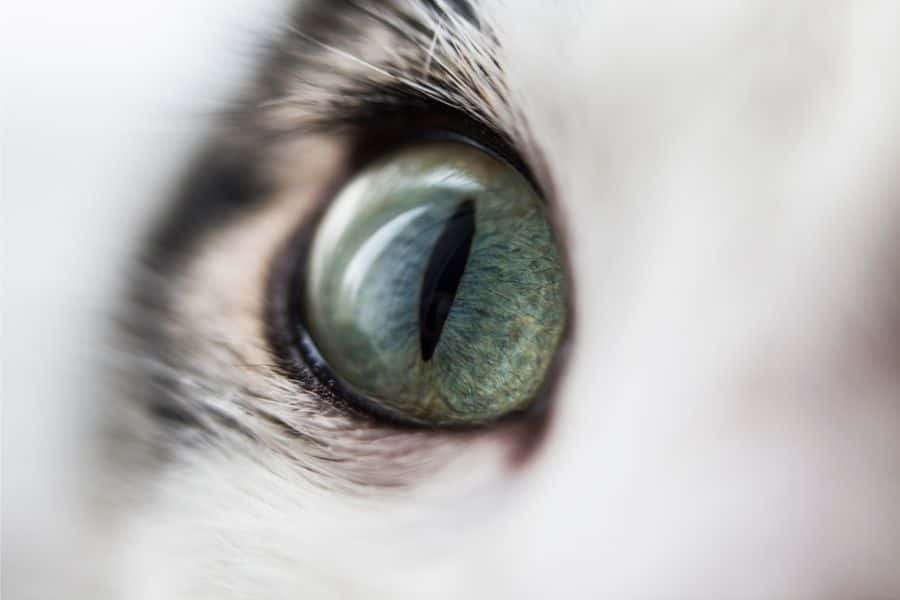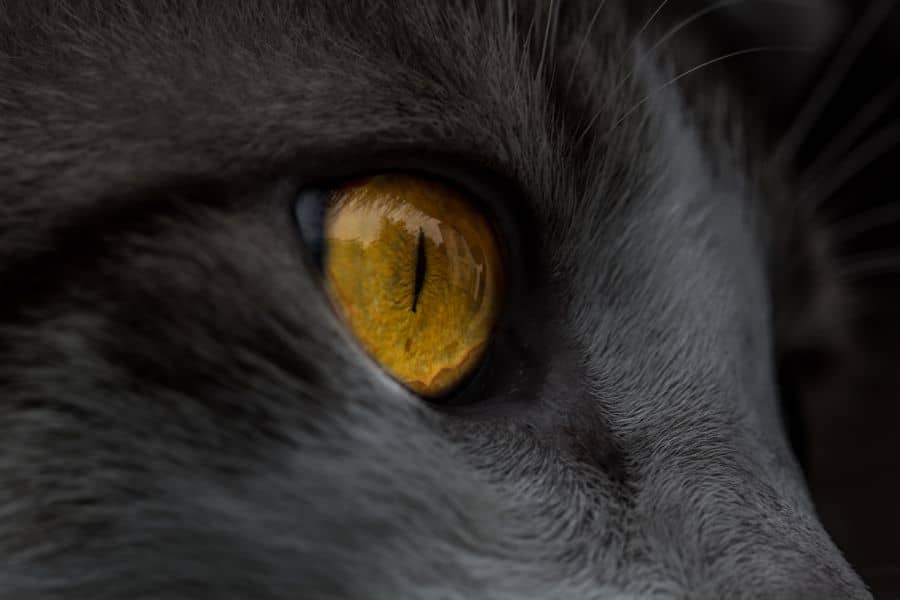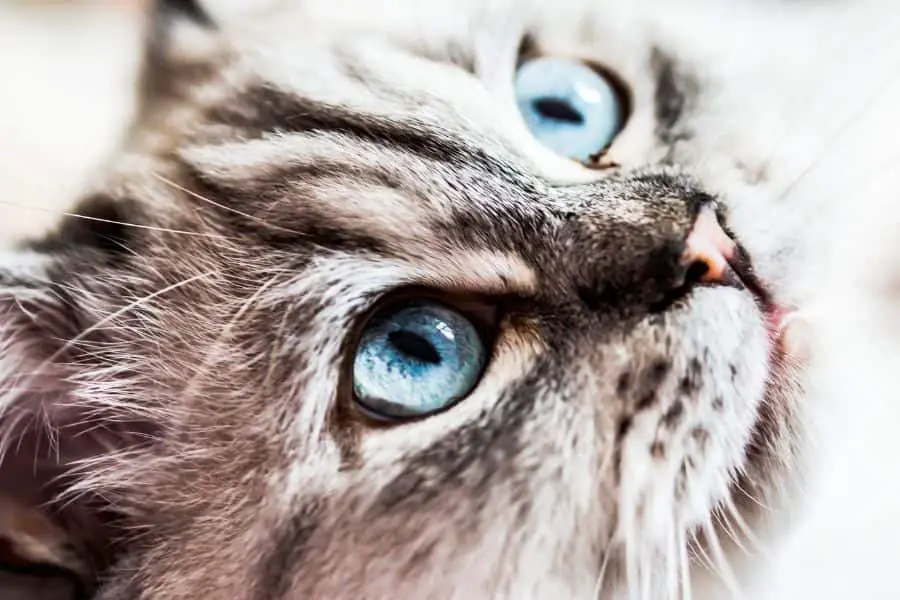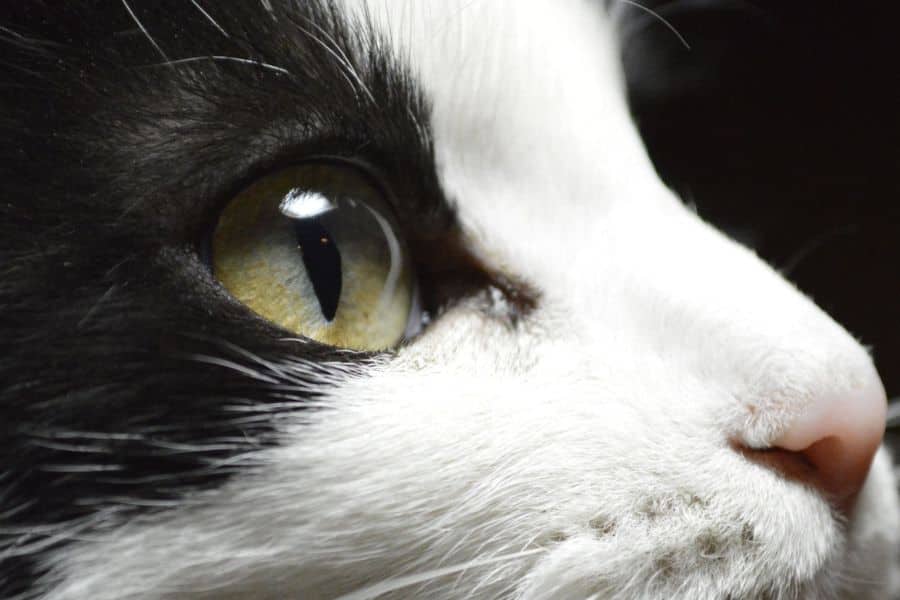Have you ever been mesmerized by your cat’s eyes and wondered if cats have eyelashes like humans? The answer might surprise you!
In this blog, I’ll answer the question, “Do cats have eyelashes?” and offer an informative guide to understanding everything there is to know about feline eyelashes. So get ready to explore the mysterious world of kitty curiosity!
Do Cats Have Eyelashes?
Do cats have eyelashes? This may seem like a simple question but it has a complicated answer. You might assume that all cats, from lions to housecats, have eyelashes. After all, humans do! Unfortunately, the answer is not straightforward; there is no one-size-fits-all answer to this question.
To understand why you must familiarize yourself with the anatomy of cats’ eyes and eyelids. While some mammals like horses and cows have upper eyelashes (generically known as “cilia” or “ciliary hairs“), cats lack them entirely. Instead of having upper lashes, most cat species rely solely on lower lashes or whiskers instead.
The exception to this rule are characteristically big-eyed kittens like Siamese Cats and Persian Cats with furred eyebrows above their eyes, effectively serving as cilia; however, this anatomical feature is more common among domestic breeds than wild cats.
Moreover, if you look very closely at domestic housecats (especially short-haired breeds), many of them possess hair follicles around their lens which may act as rudimentary lashes for protection. These could also be misidentified as eyebrow hairs because some owners find them offputting because of their appearance.
Despite being present in some felines’ anatomy in varying degrees, these rudimentary ciliary hairs lack the same purpose as full-fledged cat cilia since they noticeably lack the sensitivity and movement associated with the feline’s other whiskers.

In conclusion, it is easy to see why people often ask whether cats have eyelashes – because each breed behaves differently regarding this matter!
So next time you question if your pet has bristle above its lens, remember three things: 1) Some breeds enjoy hairy facial features (like Persians & Siameses) while others virtually none at all 2) Some housecat species can be seen sporting rudimentary eyebrow follicles which are generally harmless 3) That lastly quite unlike humans kittens lack true cilias allowing slightly better visual clarity without detrimentally blocking sun glare from reaching into their pupils directly from above.
Why Are Cat’s Lashes Hard to See?
Cat eyelashes are hard to see since they are typically shorter than humans and have a much lighter color. The inner portion of the eye has short, downward-curving lashes with dark bands on the outer edges. These serve as a protective shield, just like our eyelids, to help keep dirt and particles out of the eye area.
Additionally, since cats’ eyes have an outward taper that makes it easier to open their eyes wide when they move quickly or jump, their brows and long lashes aren’t needed as much for protection compared to humans.
In addition to the differences in anatomy, cats also have less visible lashes than humans because of their fur type. Cats typically have finer hair with little pigment on their face due to genetics and environment, whereas human eyebrows tend to be thicker with more stains. Therefore, cats’ lashes are hidden by their facial features and the naturally occurring light-toned fur many breeds tend to possess.
Generally speaking, cats’ eyes will appear wider than human eyes due in part because their lids can cover less of their eyeballs than ours can, thus exposing more of the lashes near the corners of the mouth. Fat distribution around a cat’s nose can also cause further concealment of these tiny long hairs near its snout area; breeds such as Siamese with narrower snouts often experience decreased lash visibility.
Still, some cats are luckier than others – young kittens seem to possess thicker and darker hair follicles around this part due not only to age but good genetic heritage too! Ultimately depending on these factors, it may be easier or harder for an observer to glimpse your feline friend’s fluttery features!
Do Cats Need Eyelashes?
Do cats need eyelashes? This question has been asked many times by cat owners and experts alike. The answer comes down to whether or not it is beneficial for cats to have eyelashes.
Eyelashes, or cilia as they are scientifically known, are specialized structures on the margins of the upper and lower eyelids. When functioning correctly, they can help protect animals from debris and other irritants from getting into their eyes or being rubbed on the cornea. They can also help enhance an animal’s vision in certain low-light situations, providing a layer of protraction against dust and other substances that could otherwise impair vision while still allowing the animal to see clearly.
It’s believed that cats may benefit more from having eyelashes than any other species because of their habitat and lifestyle. For example, cats are more likely than any other mammal to experience eye problems due to airborne environmental irritants like dust, dirt, and pollen particles. As such, cats may require longer eyelashes to reduce this risk and keep foreign objects out of their eye socket.
Furthermore, since felines can see better in lower light conditions than most animals due to their large pupils, having thick and long lashes might add even more protection against the potential blinding effects of bright flashes or sunlight glare in dark environments where cats often hunt and play.
In conclusion, cats do need eyelashes! They are a natural defense mechanism designed by Mother Nature specifically for our feline friends. These tiny cilia’s protective functions could be essential for keeping them safe as they take on their daily adventures outdoors!
What Is the Third Eyelid?
All cats have an extra eyelid, the third or “haw.” This unique anatomy is related to the so-called “angel’s kiss,” a bright flash in the eye associated with some cat disorders.

The third eyelid is present in all felines, including domestic cats and big cats like lions and tigers. It is a cross-shaped fold of skin situated on the inner corner of a cat’s eye that moves from side to side, covering part of its score during periods of rest or sleep when its eyes are closed for protection.
Unlike regular upper and lower lids, the movement of this third lid is not under voluntary control; instead, it reacts to certain sensory stimuli such as tiredness or external irritants like dust particles or foreign bodies. This helps to quickly disperse any debris that could damage their eyeball without annoying the cat. It also produces protective tears containing antibacterial agents that help control bacteria and any possible infection.
Functions aside, it must be said that this mystery organ looks strange when it suddenly pops up— somewhat similar to human lower lashes— but don’t worry; it’s a perfectly normal part of a cat’s anatomy! Cats don’t have lashes on both upper and lower lids as humans do; if you see them with those little cilia, you can be almost sure those are part of their third eyelid!
Feline Eyelash Disorders
Just like humans, cats may experience eyelash-related disorders. The most common condition is entropion when the eyelid curls slightly inwards and causes the eyelashes of that particular eye to rub against the eye itself.
If you’ve noticed that your cat’s eyes appear to have something wrong with their eyelash or eyelid area, they may be suffering from an eyelash disorder. While cats don’t possess the same superb vision as humans, their big eyes help them hunt at night and provide them with a sense of security in unfamiliar places. Cats’ intense eyes are partially enabled by their long and luscious lashes.
Cats face several types of eyelash disorders, which include Entropion, Trichiasis, Prolapse, Distichiasis, and Dermis License. These disorders can cause discomfort and pain for your pet by having the abnormal growth of lashes rubbing against the eye. These issues can lead to more significant implications, such as infections or ulcerations on the cornea.
Entropion
It can occur due to aging, scarring, or trauma and can irritate, tear, or discharge from the affected eye. The condition can also lead to other more severe issues, such as corneal ulceration and sight loss. *Entropion is a condition in which a cat’s upper or lower lid rolls inwards towards the eye, causing lashes to rub against it, leading to inflammation and pain.
Treatment can involve surgery or ointments depending on the severity and ensuring around-the-clock antibiotic treatments should an infection result from the condition.
Distichia
This occurs when extra eyelashes grow in an abnormal position on the cat’s eyelids. These extra lashes may rub against and irritate their eyes and become itchy or uncomfortable for the pet. To diagnose this affliction, your veterinarian will need to perform a physical examination and take samples from the eyes with a cotton swab for testing.
Hypertrichosis
This is a rare disorder in cats where abnormally long, unevenly spaced lashes grow over both eyes of a cat, often covering one entire lid while sparsely increasing on the other side (usually only two or three rows of lashes). This condition causes significant discomfort, irritation, and pain due to extreme sensitivity around the affected areas.
In some cases, cosmetic surgical duties such as carbon dioxide (CO2) laser treatment may be necessary, depending upon severity. However, no treatment is often needed for mild hypertrichosis cases besides keeping their fur trimmed around their face to reduce lash-related symptoms.
Trichiasis
It is a condition similar to entropion wherein just one lid turns inward, but it can occur less frequently due to its milder consequences. It is generally treated with artificial tears meant to lubricate your cat’s eye in conjunction with antibiotics if necessary.
Prolapse
Also known as eversion, where part of the conjunctiva is pushed out through openings between lids – this usually occurs when a cat’s blink reflex doesn’t work properly due to damage caused by scraping within the eye’s protected layer – scratching from foreign objects typically being its primary cause here. Surgery may be required here, along with antibiotics for possible infections.
Still, it should return to vision normality once successful treatments are implemented here. Though specific other complications could arise depending on severity, proper inspection is recommended before any attempts at treatment, myself stated here.
Dermis Lisencela
Results when an excess amount of lashes grow out of place, leading them to irritate against surrounding areas, thus causing pain, amongst other issues too; this disorder must like this receive attention either at preventative steps like tweezing problematic hairs away through permanent removal via surgical excision depending situations existent present.
Lastly, we have Distichia Disorder whereby instead of curved inward, so herein affected cats experience sharp inner corners poking outwards, wishing drives one’s eyeballs time resulting in loss of vision need proceed precautionary manner in case our beloved feline friend!

Symptoms of Eyelash Disorders
Certain inherited and acquired disorders can cause eyelash abnormalities, and recognizing the signs early can help improve the prognosis for some conditions. The most common symptoms of eyelash disorders include:
- Eyelashes that become sparse or shorter than normal
- Incomplete or non-uniform eyelashes
- Neonatal hypopigmentation (absence of pigment) in the hair shafts
- Chronic but reversible blepharitis, which can include cysts, crusting, and itching around the eyes and eyelids
- Eyebrow thinning or loss in adults with alopecia areata
- Ocular surface inflammation from misdirected hairs scratching or jabbing the eyeballs.
In addition to these symptoms, genetic syndromes such as Woolly Hair Syndrome involve a variety of defects affecting not only scalp hair but also facial hair, including eyebrows and eyelashes. These syndromes can be challenging to diagnose because they may also involve neurological problems, so input from a genetic specialist is critical if you suspect that you have an inherited disorder.
Eyelash Disorder Treatment
Cats have eyelashes, just like all other mammals. However, the length and appearance of these eyelashes can vary from one cat to another. Like humans, some cats may have shorter or thinner eyelashes than others due to different genetic factors.
In some cases, a cat may experience an eye disorder such as entropion that causes its upper or lower eyelids to curl inwards, leading to irritation and, in some cases, infection. This disorder can sometimes cause cats to suffer from alopecia (partial or total hair loss) around their eyes, including the loss of lashes.
When a cat is diagnosed with an eyelash disorder, treatment is available that can help restore the natural appearance of its lashes if they are missing or damaged due to the disease. The most common treatments involve surgery and medications that help reduce inflammation and swelling around the eye area.
Eyelash extension treatments are also available for cats who do not respond well to medical treatments or are otherwise unsuitable for surgery due to age or health reasons. Under such circumstances, extensions could give felines an instant boost of longer lashes without having them undergo any medical procedure or discomfort.
For chronic eye disorders such as entropion in cats, regular check-ups with a veterinarian may be necessary to monitor their progress and ensure the disease does not worsen or cause further damage. Caring owners may also consider brushing aside mats that form on their cat’s fur around its eyes during grooming sessions at home.
This could lead to trapped dirt depositing under their lashes, increasing infection chances over time if not taken care of properly and regularly. These small steps can make a big difference in preserving your pet’s eyesight health throughout its lifetime!

Complications of Eyelash Disorders
In some cases, eyelash disorders can lead to severe complications. It is essential to recognize them when present so that appropriate corrective measures can be taken. Here are a few complications of eyelash disorders that may result:
Trichiasis
When the tips of the eyelashes invert and press against the eyeball, it is known as trichiasis. Trichiasis can cause severe irritation, inflammation, and permanent damage to the cornea. It is a painful condition and requires immediate attention from an ophthalmologist.
Corneal scarring
In severe trichiasis cases, scar tissue may form on the eye’s surface due to repeated scratching of the corneal epithelium by misdirected lashes. The resulting distortion of vision can be irreversible if left untreated for too long.
Blepharoconjunctivitis
It occurs when bacteria accumulate near the base of affected eyelashes and cause an infection in both eyelids and conjunctival membranes (the membranes surrounding your eyes). The most common symptoms are burning or stinging pain, redness, itching, excessive tearing, discharge from affected areas, and possibly even crusting lids or lashes. Treatment includes antibiotics and daily cleaning with warm water or Baby Shampoo.
Conclusion
Eyelashes are a vital defense mechanism in some animals, such as cats, horses, elephants, and even birds. They help keep foreign objects out of the eyes and help prevent eye injuries. While not every cat has eyelashes, some do.
Although some cats may be born without these protective devices, others subject to certain medications or surgeries may grow them back over time after their body has finished healing. Eyelashes are also sometimes seen on cats who have undergone eye surgery without their owners’ knowledge – these tend to grow back after the cat has recovered!
Depending on the individual animal, eyelashes can play a variety of different roles. For example, they might be used to keep dust and debris out of the eye, protect the eye when it is open, or enhance vision.
So when do cats lose their eyelashes? The answer is that it depends on the individual cat. Some cats will never have eyelashes, while others may have tiny cilia on the corners of their eyes. Although it is essential to know the potential signs of a possible loss of eyelashes, some cats may never need to worry about this because they never had them in the first place!
However, if you notice your cat suddenly developing any medical condition (such as a runny nose or eye discharge) or are concerned that your cat’s eyes are not as straightforward as they used to be.
